There’s a common misconception that businesses need to acquire new customers if they want to make more money.
Getting new customers is obviously beneficial and can help your business grow. But that’s not the only way to boost your profits.
Focusing on customer retention is a much more viable and cost-effective marketing strategy.
In fact, it will cost you six to seven times more money to acquire a new customer than it will to retain an existing one.
Not only is retention cheaper than acquisition, but it also has a very high ROI. Research shows that you can increase your profits anywhere from 25-95% just by increasing your retention rates by 5%.
Imagine how much more money you’ll make if you increase those retention rates by 10% or even 20%.
Don’t get me wrong: I’m not saying you should completely ignore your acquisition efforts. But if you are looking for ways to market your company on a budget, it’s in your best interest to focus on your existing customers.
Take a look at these loyalty statistics for ecommerce brands:
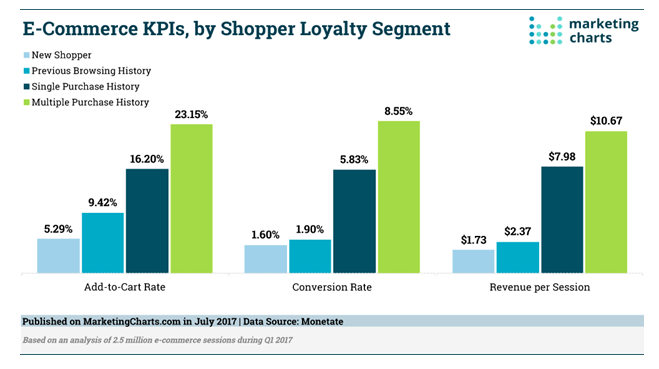
As you can see, customers who have made multiple purchases with a brand have a higher add-to-cart rate and conversion rate than new shoppers.
These customers also generate more than six times the revenue per session than new shoppers.
So it only makes sense that you should be prioritizing these customers.
I’m sure you’ve heard this age-old proverb: “A bird in the hand is worth two in the bush.”
You’ve already got these customers in your hand. Don’t risk losing them by putting all your effort into customer acquisition.
I’ll show you the best ways to increase profits with customer retention.
Leverage your blog to establish loyal readers
Most people may not associate blogging with customer retention. But blogging overall is one of my favorite content marketing strategies.
In addition to helping you increase website traffic and generate new leads, blogging can also help you engage with your loyal customers. This is especially true for ecommerce brands.
Ask yourself this question.
How often does the same customer visit your website?
I’m guessing you’re not getting repeat purchases from the same customer on a daily basis.
But if you’re releasing new blog posts each day, or even a few times per week, you give your customers a reason to keep checking your website.
Hook these readers with your content. If they use your products and read your blog, your brand will be on their minds more often.
Plus, the more they visit your site, the greater chance you have of getting them to buy something else. This strategy is extremely cost-effective.
The only major cost is the time it takes to write each post. In 2017, the average time it took people to write a blog post was just over three hours.

It’s well worth your time and effort if you’re able to leverage this strategy to create loyal readers and retain your existing customers.
Use surveys and interviews to get feedback
In order for you to properly focus on retention, it’s important for you to understand what causes customers to leave a business.
Research shows 68% of consumers leave a business because they don’t feel the brand is valuing them.
Only 14% will leave because they’re unhappy with your product or service. And 9% of customers leave because of your prices.
What does this tell you?
Customers care significantly more about how they’re treated than the products and prices of what they’re buying.
One of the best ways to show your customers how much you care about their opinions is by asking them directly. You can use surveys and interviews to generate more revenue for your business.
This strategy accomplishes a few things.
First, it shows customers you care about them, which we already established. But the results of these surveys and interviews can also help you make your business better.
If you’re doing something wrong or your brand could use some improvement, you’ll find out from these campaigns.
Once you’re able to identify what needs to be fixed, customers will be happy to see these changes get applied.
This type of service enhances the customer experience, which I’ll elaborate on in greater detail shortly.
Implement a customer loyalty program
The name says it all. The purpose of establishing a customer loyalty program is to create loyal customers.
Research shows that consumers are much more likely to shop at stores with loyalty programs.
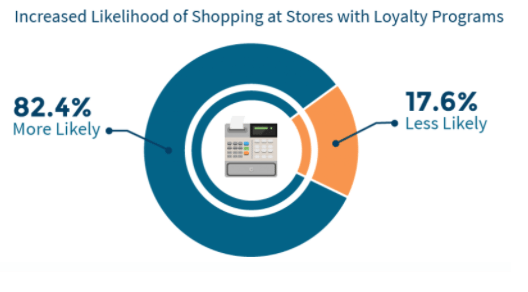
Give your customers what they want.
There are many different ways to approach your loyalty program. For example, you can reward your customers based on how often they shop.
These types of programs have been around forever, and I’m sure you’ve participated in them during your life.
A local pizza shop in town may give out punch cards to their customers. After ten visits, they get a free pizza.
But with the advancements in technology, this type of “punch card system” has evolved. Businesses with mobile apps have been able to eliminate the need for customers to carry a physical card. We’ll discuss mobile apps in greater depth as we continue.
If your business operates online, you can track your customers’ purchases through their profiles.
Another type of loyalty program rewards your best customers. For example, let’s say two customers each made a purchase from your store ten times in the last six months.
Should they both be rewarded equally?
If one customer spent $100 and the other customer spent $1,000, it makes sense to reward the customer who spends more money.
You can implement a customer loyalty program with various spending tiers. Each time a new customer reaches another level, they’ll receive a more significant benefit.
This strategy gives your existing customers an incentive to spend more money since they know they’ll be rewarded. As a result, it will be much easier to retain these customers.
Grow your email list
Another great way to focus on customer retention is through email marketing.
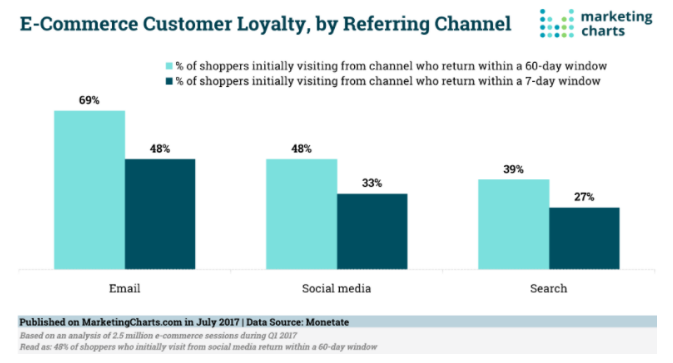
As you can see from this chart, email yielded the highest results for customers who return to ecommerce websites compared to other referring channels.
You should be collecting email addresses from your current customers.
Once you have their email addresses added to your list, you’ll be able to send them exclusive offers and promotions.
This will increase the chances of them buying again. They won’t not be making repeat purchases so frequently if you aren’t reminding them of these offers via email.
Just don’t go overboard with these messages, or it could backfire.
Don’t send promotional content to your subscribers on a daily basis. This will annoy them and lead to lots of unsubscribes from your list.
Instead, only send content that adds value to their lives. For the most part, you can’t go wrong with a discount. It’s a great way to drive sales from your existing customers.
Incentivize customer referrals
Most businesses would consider customer referral programs as an acquisition strategy.
While I’m not disputing that, I want you to understand that they can also double as a retention strategy if you set them up properly.
The whole idea of a referral program is to get your current clientele to bring in new customers. But most people won’t do this out of the kindness of their hearts.
Sure, they might like your brand and be happy with your products, but do they love you enough to go out of their way to spread the word to their friends and family?
That’s why you need to offer an incentive for referrals. Check out this example from Airbnb.

It’s a simple structure. Customers who refer their friends will receive a $20 credit after the person they referred books a trip.
So yes, they’re getting a new customer. But their existing customer also has a reason to make another purchase since they want to take advantage of their credit.
The more people they refer, the more money they’ll receive in travel credits.
You can implement this same type of referral structure to your business. It will reward your customers for their efforts and give them a reason to continue making purchases in the future.
Offer product suggestions
You should be encouraging your customers to create a profile on your platform.
This will help you personalize their shopping experience. Personalization has major benefits to consumers and brands alike.
These customer profiles will allow you to monitor their purchase history and browsing behavior.
Now you can use this information to recommend products to your customers.
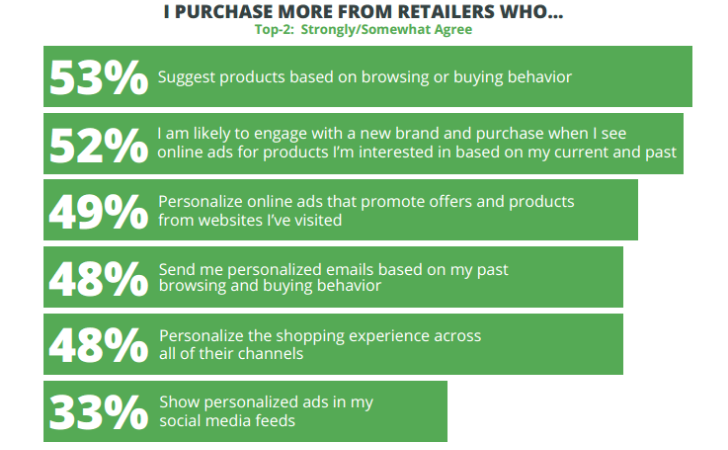
As you can see from these numbers, consumers are more likely to buy from brands that suggest products based on their purchases and browsing behavior.
Nearly half of consumers say they purchase more from retailers who personalize their shopping experience and send personalized emails.
These product suggestions are a great way to make more money. For example, let’s say you have an ecommerce store that sells sporting goods.
If a customer adds soccer cleats and a soccer ball to their shopping cart, it’s a pretty good indication that they’re playing soccer.
So before they checkout and complete the purchase, you could recommend shin guards, soccer socks, and a water bottle as potential suggested items they might be interested in buying.
This will help increase the average amount of each transaction.
Provide excellent customer service
I briefly touched on this subject earlier when we talked about using surveys and interviews to get feedback from your customers.
But excellent customer service goes far beyond that.
This needs to be a priority for your business. Customer service needs to part of your overall company culture.
From the CEO all the way down to the employees at the bottom of the organizational chain, everyone needs to know how to treat customers.
Improving the customer experience will help you drive loyalty and retention.

Make sure you’re available to help your customers.
Let them reach out to customer service agents via as many methods as possible:
Just because your business operates from 9 AM to 5 PM EST on Monday through Friday doesn’t mean your customer service hours end then.
What if a customer on the West coast has a question on Friday at 6 PM local time? Don’t make them wait until Monday morning to call you.
Give them options. Go the extra mile to keep your customers happy.
According to studies, 86% of people say they are willing to pay more money for better customer service.
That’s right. You could charge more for your products and services if you treat your customers the right way. They’ll still keep coming back to buy more.
Segment your email list
Earlier I explained that you need to add subscribers to your email list.
Now I’m telling you to take that strategy one step further. You need to segment your subscribers to maximize your email campaigns.
There are plenty of ways in which you can do this. For example, you can put them in lists based on their age, gender, or location.
You can even segment your target audience with generational marketing.
Putting your email subscribers on separate lists helps you deliver more personalized content to each person.
Take a look at some of the top benefits of email segmentation:
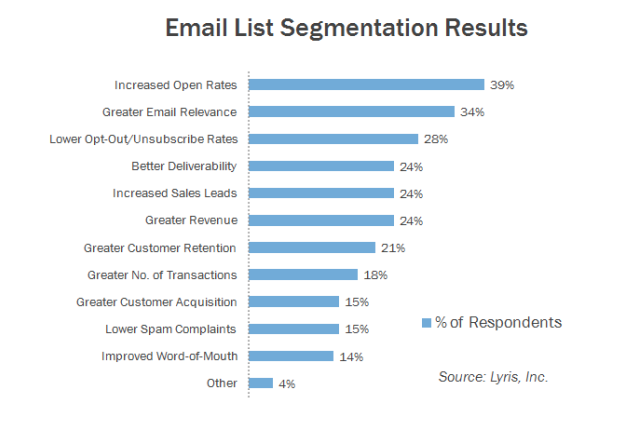
If you go through each one of these benefits, you’ll notice they all translate into one common result.
All of these will help you generate more profits.
Develop a mobile app
We live in a world where mobile technology has seemingly taken over.
When was the last time you saw someone without a cellphone?
Building a mobile app can have tons of benefits for your business.
As I explained earlier, an app can replace a physical customer loyalty card. You can also use your app to implement other strategies I’ve discussed, such as a customer referral program, product suggestions, and a platform for customer surveys.
Furthermore, you can use your app to improve your customer service. Allow app users to contact a representative directly from within the app.
As far as retention goes, mobile apps create a 50% greater chance that an ecommerce customer will return to your online store within 30 days.

Mobile apps also have extremely low shopping cart abandonment rates.
The average shopping cart abandonment rate for a desktop site is 68%. When customers add an item to their shopping carts from a mobile browser, that number jumps to 97%.
But with mobile apps, the shopping cart abandonment rate is only 20%.
You can get that percentage down even lower if you follow my high ROI shopping cart abandonment prevention tactics.
Conclusion
New customers aren’t the only way to increase profits for your business. Focusing on customer loyalty is more effective and cost-efficient.
Use your blog as a way to get your customers to visit your website on a more frequent basis.
Show your customers you care about them by asking their opinions with surveys and interviews. Create a customer loyalty program.
Provide incentives to your customers who refer friends and family.
Add customers to your email list and segment those subscribers to personalize your marketing campaigns. Take that personalization one step further, and suggest products based on the browsing history and previous purchases of your customers.
If you enhance your customer service, you can even charge more money for your products and services.
Develop a mobile app to help you implement these strategies and drive more sales.
By prioritizing customer retention, you’ll be able to generate higher profits.
What customer retention strategies does your brand use to drive more sales?

Source Quick Sprout https://ift.tt/2n2EJI7










